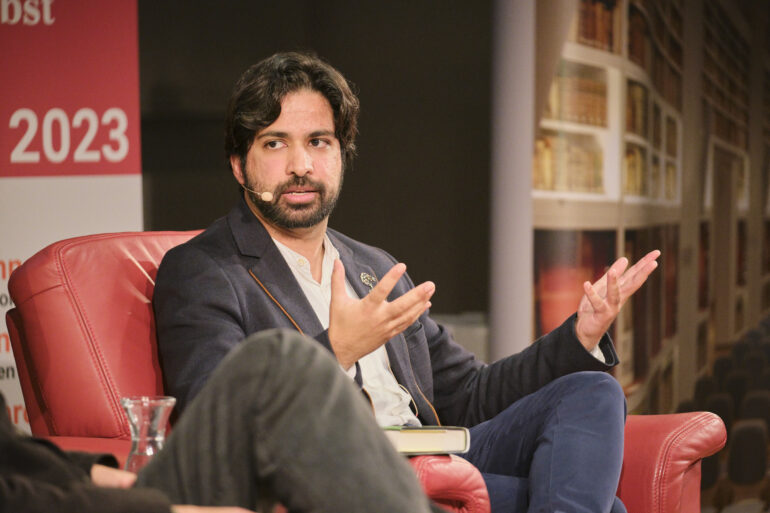With the presentation of his book How to Live with Each Other: An Anthropologist’s Notes on Sharing a Divided World at the Göttinger Literaturherbst, Farhan Samanani discusses different ways of coexistence. Using examples of harmonious multicultural communities, he makes suggestions on how we can rethink our ideas of living together.
By Arezoo Izadi and Jaeeun Kim
Picture: Martin Liebetruth
On Wednesday, November 1st, Farhan Samanani discusses his book How to Live with Each Other: An Anthropologist’s Notes on Sharing a Divided World, celebrating the publication of the book’s German translation titled Miteinander: Über das Zusammenleben in einer gespaltenen Welt. The event within the programme of the Göttinger Literaturherbst starts with the introduction of the author by Steven Vertovec, the founding director of the Max Planck Institute for the Study of Religious and Ethnic Diversity in Göttingen, who knows Samanani well. This is not surprising as Samanani – now a lecturer in Social Justice at King’s College London – is an alumnus of this very institute. Samanani’s presentation of the book is followed by a talk between him and Vertovec as well as follow-up questions by the audience.
Kilburn and the Multicultural Community
The author starts with the intriguing example of Kilburn, a multicultural neighborhood of London, and how the members of the Kilburn society – different generations of non-migrants and migrants with diverse ethnical, national, religious, political and class backgrounds, different languages and histories – are living together. According to Samanani, Kilburn is a harmonious haven of different groups, the place where »no one single group dominates« and members of various backgrounds live together in harmony. Kilburn is one of various examples that show the possibility of people with differences coexisting without major conflict.
Along with reading a few excerpts from his book, Farhan Samanani starts to explain that as humans we encounter different individuals on a daily basis, and the question of »how we can live with one another« always presents itself anew. Nevertheless, he suggests that this task may not be as much of a challenge as we assume it to be. He puts forth the idea that we can think about difference and distinction anthropologically, since anthropology is the science of being with others, by discovering various ways of living or being human. Instead of considering the difference as a source of conflict, he shows the example of the places, including Kilburn, where difference does not cause conflict but rather become chances to understand diversity.
Anthropologist and Cultural Perspectives on Distinction
Samanani points out that as humans we know and show ourselves not only by comparing similarities but also by our differences. In other words, one of the ways in which we, as humans, identify and express ourselves is through exploring how different we are from those around us and by distinguishing ourselves from other people. This can prove to be tricky once we come to know the extent of this difference. However, he also explains that we should be aware that even if another individual’s beliefs appear outlandish and strange, it can be a different expression of similar underlying needs or ideas that we ourselves have.
He goes on to give an example of an eye-opening academic study on schizophrenia, in which an anthropologist collaborated with multidisciplinary academics to study this mental disorder in three different countries: the United States, India and Ghana. The result of this research indicated that schizophrenic individuals from different places would hear the voices of different people in their head depending on their culture, e.g. violent threats, amicable advice or voices of spirits. Jokingly, Mr. Samanani raised the question that, considering this research, what then is the »right« way to be schizophrenic? Are the Americans »right« and the others are not? The voices reflect the culture, and the differing voices may seem outlandish to people from other cultures, but they are still the same symptom, varying among cultures.
In line with his anthropological approach, Samanani then introduces some other examples of individual cases of harmonious havens of diverse cultures, including the example of The Door, an institute in Kilburn that was mainly for religious practice of muslim community. The Door opened its door to non-religious visitors and lend the space for non-muslim communities for events, playing a mediating role between people with differences. He also briefly mentions the perspective of political sciences on conflicts and differences – policies regarding foreigners for example – since policies and social consciousness are inseparable. However, since he focuses on specific cases in which diverse cultures coexist in peace, Samanani suggests the possibilities of the space of coexistence in many different forms rather than giving a one-size-fits-all solution for every situation.
A New Narrative
The Q&A session with the audience starts with the question of how to fill in the gap between Samanani’s positive examples and the policies related to difference. He stresses the power of narrative by explaining how the perspective of losing oneself while facing a new culture can be shifted into the perspective of the chance of discovering a new self with the shift of narrative. He further emphasizes the deep connection between social consciousness, or the consciousness of individuals on society and one another in it, and anthropology, and how we must not easily disregard political and social reality, particularly in spaces where the conflict between different interest groups is not easily dissolved with one or two policies. In addition, Samanani argues that social consciousness and political actions should develop reciprocally instead of one preceding the other. He concludes that we should stop treating difference and the discourse around it as if it were an issue that must be solved.
Samanani’s witty explanation on the examples of how people can deal with differences, forms an optimistic atmosphere and encourages the audience to think of their own ways of dealing with other people. Samanani’s book and his discussion with Vertovec do not only provide ideas and models of coexistence, but they also offer a space for thoughts for the audience, which can be a good starter for coexistence.






